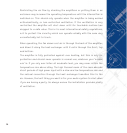
12
If an amplifier can provide this amount of current into the specified load
while keeping safe and stable and not suddenly dropping its output voltage,
it is enough. The load cannot draw any more. The current draw is the result
of the voltage applied.
If an amplifier protects itself by ‘current limiting’ it will drop its output
voltage if too much current is demanded. This is a bad thing for an audio
amplifier, but not uncommon. If the current limiting never operates under
real conditions it is both a harmless and a good way to protect an audio
amplifier. The problem can then be to know if the protection ever triggers or
not. This nagging doubt, though often ill-founded, has resulted in some
concern (and boasts) about amplifier output current.
The Klimax, like all Linn amplifiers, is specified into a 4 Ohm load. We don’t
do this to claim a bigger output power, but to show that our amplifiers are
intended and fully specified for operation into 4 Ohm loudspeakers. Most
Linn loudspeakers have nominally 4 Ohms input impedance.
Like all our discrete amplifiers the Klimax has a simple decision making
protection circuit. Either the output current is safe or it’s not, in which
case the amplifier is shut down instantly for a few seconds. An unsafe output
current is defined as a particular level above a certain threshold for a
specified length of time, or an instantaneous current above an absolute
threshold. If neither of these conditions are violated the amplifier is delivering
all the current requested by the load. It’s very easy to tell when our protection
circuitry triggers; the amplifier stops.


















